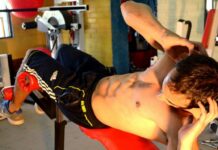People who play sports have the dreaded injuries as one of their greatest enemies; therefore, avoiding injuries is one of the obsessions of athletes.
It is easy to understand why this is so, since if an athlete is injured, they must stop training immediately. This will make the athlete completely lose his progression, something that will make him frustrated and above all, it will make him lose pace with respect to his competitors.

A good example is weightlifting injuries, since people who are injured in this type of exercise then have to spend some time without training. Then they must spend some time training at low repetitions and finally it can take a long time for them to regain their strength, since all this time without exercising means that the muscle they had been lost.
The same applies to other sports such as athletics, team sports or even sports where there is not much physical wear. For these reasons, avoiding injuries should be something that should not only be an option, but should be mandatory for all elite athletes who one day wants to be good.
In addition, we are not counting the psychological factor that injuries suppose for an athlete, since when we get injured we are going to feel very bad mentally, as broken inside and out. This adds to the frustration we feel when losing strength, speed, ability… when fully recovering from the injury, realizing that we almost have to start from 0 to get back on top.
But we are not going to get sad so easily, since actually avoiding injuring ourselves is much easier than people think, you just have to have a little common sense and a little “sight” when doing things. Stuff.
Today I will show you the best tips that exist to avoid injuries during training, some tips that will give you precise instructions on what you should and should not do to avoid sports injuries of any kind, applying to most sports. They are also instructions that an athlete of almost any level can do, that is, I advise you to do all this whether or not you are a competitive athlete, since in a normal person, avoiding injuries is also very important.
Instructions to avoid injury
- Before training:
In this article, I have decided to divide the injury prevention and protection protocol into 4 well-differentiated parts, so that you not only know what you should do, but also when you should do it. I have divided it into the period before training, the period while you train, the period after training and finally the days between one training and another. We are going to start with before training, at a time in which we must be very careful, since we are very cold and the difference in temperature could make us easily injured. Let’s see all the things we have to do before training.- Plan training:
The first thing we must always keep in mind is never to train improvised, that is, whenever possible, training should be fully planned. This gesture prevents injuries, because it can make us do a training that is really adapted to us, not a training that is harmful and that is carried away more by the heat of the moment than by something really solid. Plan the training according to your objectives, your level of training and do it well in advance, so that there are no surprises. - Warm-up:
I advise you to do joint mobility exercises before training, exercises that will serve to prepare the muscle for exercise. If we don’t warm up, the muscle will be too cold, so its elasticity will be compromised and the risk of injury increases exponentially. Move all the parts of your body gently until they warm up and be ready for what’s coming. - Prepare the material:
Finally has all the sports equipment ready, such as your running shoes, your spare shoes and your suitable sweatpants. I also advise you to have a first aid kit, because although it is not prevention (it is already protection), you will be able to avoid a serious injury if you treat any wound, accident or infection in time.
- Plan training:
- During training:
Once we have defined the period before training, we go there with the during training. This period is the most important of all, since it is when there is the greatest risk of real injury (we are breaking muscle fibers and using a lot of bones and joints), therefore, special care must be taken to avoid injuries. We are going to be able to do several ways to do this phase correctly, phases that you probably already knew, but that you were not used to doing normally.- Approach series:
This really is a warm-up, but it is done already training. An approach series consists of performing the exercise you are going to do, but in a smooth way, progressively approaching the objective of the final series. For example in bodybuilding, if your goal is to do a series with 100 kilos in bench press, do several warm-up series with 40, 60, 80 and 90 kilos, series that will prepare the muscles to exercise progressively? It also applies to other exercises such as sprinting, where you will have to run slowly first to avoid injury and then run quickly. - Correct technique:
To do the technique correctly, you should look at how professionals do it, since they do it well precisely so as not to injure themselves, since this would cost them too much money and even their career. A correct technique will allow you to avoid injuries in any sport and not only that, but it will also help you achieve better results. Practice until you get the right technique, something that is difficult at first, but it ends up being achieved. If you have a hard time, try to improve your flexibility, since flexibility is a quality that helps improve technique in most exercises. - Realistic goals:
This is something that happens a lot, especially in strength sports. In these cases, the athlete usually puts too much weight and too much volume into training, thus exponentially multiplying the risk of injury. For this reason, the ideal is to set realistic goals, which are a challenge, but that are within your possibilities. Be patient and keep training at your own pace and in the end you will be able to put in those weights or make those marks, but give yourself time to grow.
- Approach series:
- Post-training:
The post-training period is also very important, because here we have just finished training and the muscle is completely destroyed. Right now, if we don’t do some things correctly, we could come to the next training session resentful and injure ourselves. Here I offer you the best tips to perform after training.- Cool down progressively:
After a very high intensity exercise I do not advise stopping cold, as this is bad for the muscles. Instead, try a low-intensity warm-up type exercise until your heart rate and body return to normal. For example, if you’ve done sprinting, try walking briskly for a half mile or more so your heart rate slowly drops. - Stretch:
When we have done sports, the muscle is stiff, therefore, we must stretch. Stretching is good for the muscles, as it helps more oxygen to reach the muscle fibers, something that will help faster muscle recovery. Perform stretches once you are at rest, focusing mainly on the muscles that you have used. This phase must be calm, controlling your breathing and avoiding forcing yourself too much, since it does not consist of injuring yourself while stretching.
- Cool down progressively:
- Between one workout and another:
Last but not least, we have the phase between workouts, a phase that we should not underestimate, since it is the phase in which our muscles are recovering from the previous exercise. Therefore, we must take care that they recover properly, to return stronger to the next training. The importance of rest is explained by science, since by breaking muscle fibers, the body performs what is called super compensation, an act in which the fiber is repaired and becomes a little stronger, to prevent the fiber from breaking. Next time. For this phenomenon to occur, we must rest well, since the body must take its time to do it correctly. Follow these tips for a good rest and a good recovery and you will avoid injuries.- Sleep well:
The period where the body recovers the most is during sleep, since here we are practically deactivated and the body can take advantage of it to repair its muscle fibers. Also while we sleep, we generate more testosterone and growth hormone, key hormones in muscle recovery. Sleep at least 8 hours a day to achieve optimal muscle recovery, since only in this way will you be able to achieve good results. - Eat well:
A bodybuilder said that there is no such thing as overtraining, only undernourishment. This is true in part, as the more we eat, the more nutrients the body has to rebuild muscle, however, overeating can cause obesity. What you have to do is nourish yourself after training, so that the body sends the nutrients directly to the muscle. Also eat clean foods that take advantage of the muscle and avoid foods based on sugar and processed flours. - Leave enough time:
The muscle needs rest and in many sports, it is not good to train every day. Therefore, try to control the rest periods well in order to progress. Likewise, if you feel very tired, with little energy and in pain, stop training for a while until you are fully recovered, as this may be a warning of injury.
- Sleep well:

















